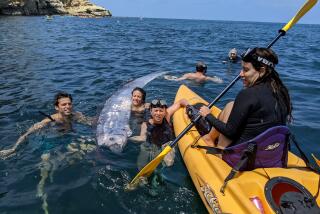Outdoor Notes : A Long-Ranger Has a Big Catch
- Share via
San Diego’s long-range sportsfishing fleet, which began its traditional schedule of 16-day trips south in search of giant yellowfin tuna on the day after Christmas, is still at sea.
But the Royal Polaris got a taste of the action early, having returned from the islands off southern Mexico just before Christmas. Although the boat didn’t find the giant yellowfin--the fish are known to grow beyond 300 pounds--sometimes associated with such trips, the 30 fishermen aboard did have a memorable outing.
A total of 576 yellowfins were caught, though none topped the 200-pound mark, along with 127 wahoo, 1 black marlin, 66 groupers, 5 rainbow runners and 11 dorado.
The top fish was a 172.4-pound yellowfin caught by Greg Mayer, a visitor from New Jersey.
Meanwhile, the Searcher, on a scheduled 9-day trip, returned from the Alijos Rocks off Baja California 2 days early on Monday because its fish hold was full.
There were 22 anglers aboard who caught 440 yellowfins. The largest was a 91.2-pounder caught by Lloyd Doyle of Cerritos.
Fishing in the waters off San Diego will improve somewhat in the near future if 2 fish aggregating devices do what they are supposed to do when they are deployed later this year.
The FADs, each of which is composed of 90 strands of polypropylene fronds attached to a chain under a buoy anchored to the ocean’s bottom, will be put in 3,000 feet of water 15 miles west of Mission Bay and at 300 feet 5 miles west of Mission Bay.
John Hall, the principal investigator for the Sea World Research Institute’s project, said the FADs differ from artificial reefs in that they are meant to attract fish seasonally, rather than a resident population of bottom fish.
The strands are situated on the upper 90 feet of chain.
“It’s not like a city where fish move in and stay,” Hall said. “These fish are expected to come and go on a seasonal basis.”
Hall said he expects bait fish such as anchovies to be the first to school near the devices, within 30 days of deployment, which is tentatively scheduled for early March. Eventually, Hall says, the FADs will attract such game fish as bonito, barracuda, yellowtail, dorado and even albacore.
Anchored fish aggregating devices were first used by Philippine fishermen before World War II, and more than 1,000 are in use in the Pacific and Indian oceans.
Hall says the vast majority of commercial tuna caught in the western Pacific and Indian oceans are taken by setting nets near such devices. In Hawaii, FADs are yielding about 240 pounds of fish per boat, per visit, to recreational fishermen.
Theories as to why fish are attracted to such devices range from the shelter and shade they provide, to their function as a schooling companion for migratory fish, to their being a simple reference point in a trackless sea.
More to Read
Sign up for The Wild
We’ll help you find the best places to hike, bike and run, as well as the perfect silent spots for meditation and yoga.
You may occasionally receive promotional content from the Los Angeles Times.






